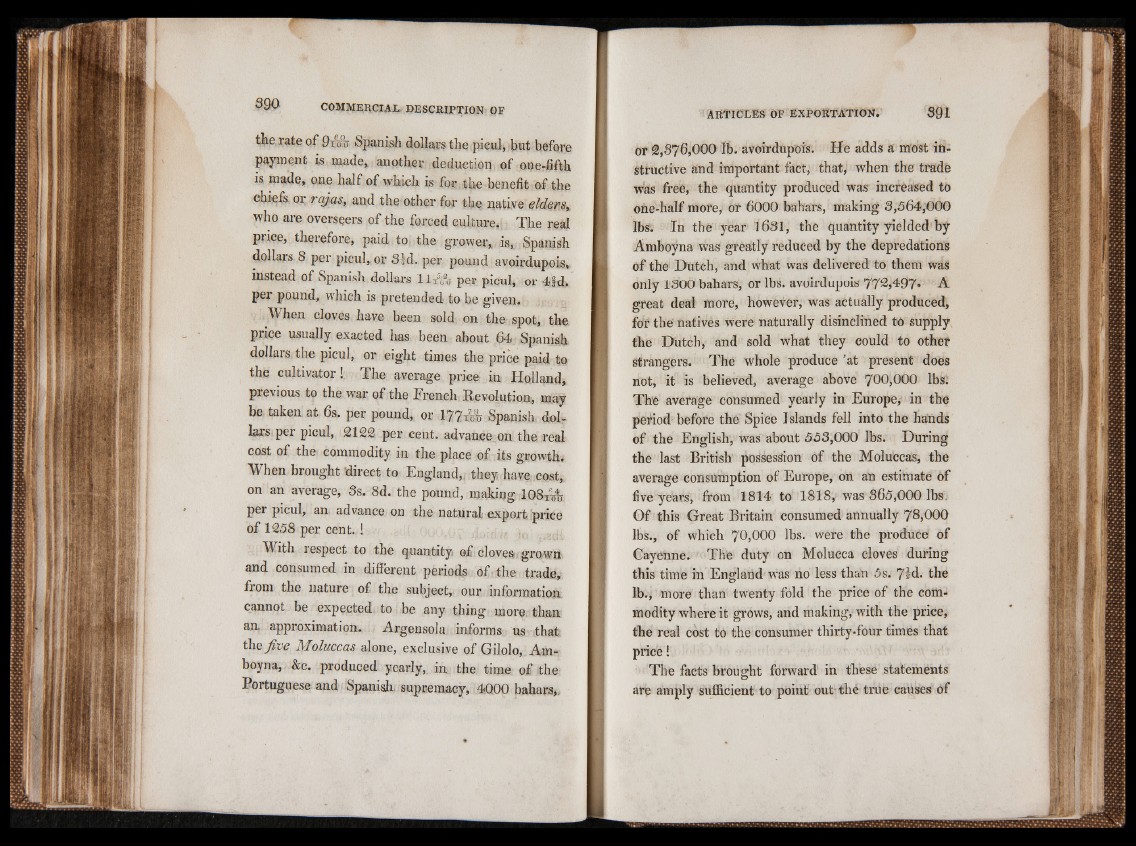
the rate of 9i<& Spanish dollars the picul, hot before
payment is made, another deduction of one-fifth
is made, one half of which is for the benefit of the
chiefs or rajas, and the other for the native elders,
who are overseers of the forced culture. The real
price, therefore, paid to the grower, is, Spanish
dollazs 8 per picul, or Sid. per pound avoirdupois,,
instead of Spanish dollars lli^g per picul, or 4 |d.
per pound, which is pretended- to be given.
When cloves have been sold on the spot, the
price usually exacted Iras been about 64 Spanish
dollars the picul, or eight times the price paid to
the cultivator!. The average price in Holland,
previous to the war of the Trench Revolution, may
be taken at 6s. per pound, or 177W Spanish, dollars
per picul, M m per cent, advance on the real
cost of the commodity in the place of its growth.
When brought direct to England,; they have cost,
on an average, Ss. 8d. the pound, making 108x3%
per picul, an advance on the natural- export price
of 1258 per cent.!
"With lespect to the quantity o£ cloves grown
and consumed in different periods of the trade,
from the nature of the subject, our information
cannot be expected to be any thing more than
an approximation. Argensola informs us that
thefive Moluccas alone, exclusive of Gilolo, Am-
boyna, &c. produced yearly, in the time of the
Portuguese and Spanish, supremacy, 4000 bahars,.
of 2,376,000 lb. avoirdupois. He adds a most instructive
and important fact, that, when the trade
was free, the quantity produced was increased to
one-half more, or 6000 bahars, making 3,564,000
lbs. In the year 1681, the quantity yielded by
Amboyna was greatly reduced by the depredations
of the Dutch, and what was delivered to them was
only 1300 bahars, or lbs. avoirdupois 772,497* A
great deal more, however, was actually produced,
for the natives were naturally disinclined to supply
the Dutch, and sold what they could to other
strangers. The whole produce 'at present does
not, it is believed, average above 700,000 lbs:
The average consumed yearly in Europe; in the
petiod before the Spice Islands fell into the hands
of the English, was about 553,000 lbs. During
the last British possession of the Moluccas, the
average consumption of Europe, on an estimate of
five years, from 1814 to 1818, was 365,000 lbs.
Gf this Great Britain consumed annually 78,000
lbs., of which 70,000 lbs. were the produce of
Cayenne. The duty on Molucca cloves during
this time in England was no less than 5s. 7 $d. the
lb., more than twenty fold the price of the commodity
where it grows, and making, with the price,
the real cost to the consumer thirty-four times that
price!
The facts brought forward1 in these statements
are amply sufficient to point out the true causes of